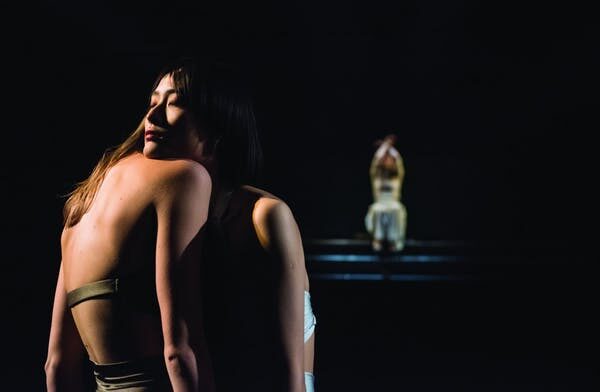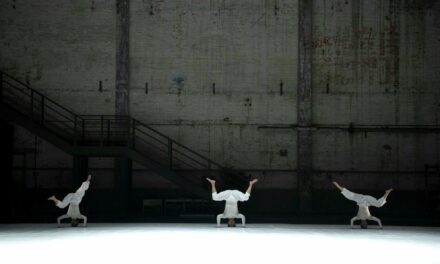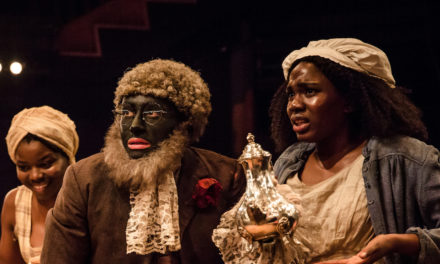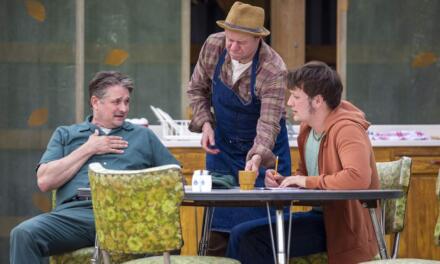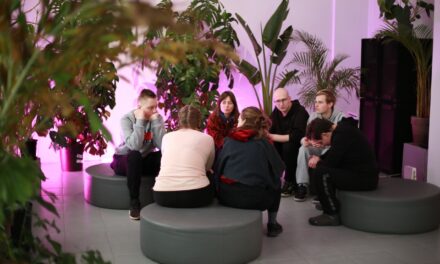In an age of growing mistrust, the Chinese-Australian artistic collaboration One Infinity demonstrates the ability of dance and music to navigate tensions between different cultures.
As the Chinese title of the show (Chu. Wuying 初.無垠, literally “Beginning, No Border”) suggests, the performance aims to take us back to the beginning of time, to a world without boundaries. It explores connection and disconnection; nature and culture, taking cross-cultural music and dance collaboration to a new level.
Produced by Playking Productions (Australia) and Jun Tian Fang (China), the show is directed and choreographed by Gideon Obarzanek (Australia), and features dancers from both Beijing and Dance Theatre and Townsville-based Dancenorth Australia.
One Infinity takes place on a softly-lit center stage with a reflective floor resembling a mirror or a lake’s surface where the musicians and dancers float. Mirror and reflection, water and nature, are all major motifs in the hour-long performance.
It begins with a melodic dialogue between two chirping birds, represented by Australian recorder virtuoso Genevieve Lacey’s recorder and a Chinese flute. This is followed by renowned guqin master Wang Peng’s performance of the classic solo piece, Wild Geese Descending on the Sandbank (Pingsha Luoyan).
With that, ten dancers are revealed under the spotlights, seated among the audience (five dancers from the Beijing Dance Theatre on one side, and five from Dancenorth Australia on the other).
The two quintets morph into flocks of birds, which at times also resemble two giant butterflies flapping their wings, both being common motifs in classical Chinese nature poetry and painting.
Equally impressive is the Jun Tian Fang Music Ensemble’s classical duet “Two Flowing Waters (shuang liushui)” , where two guqins imitate the flowing water of two intersecting streams.
Entering a phase of exchange between the two dance companies, these early poetic dialogues are followed by a series of dance sequences that see continuously changing dynamics among the dancers.
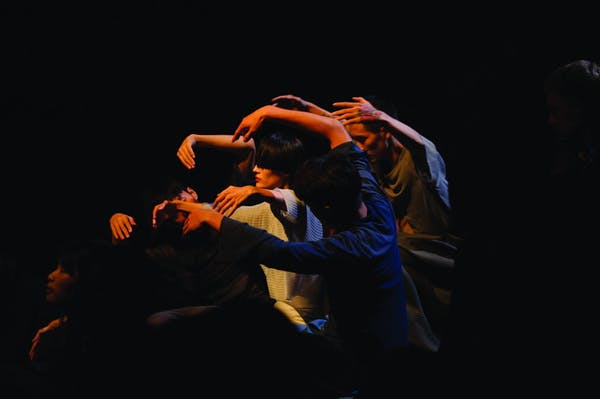
One Infinity features dancers from Beijing Dance Theatre and Dancenorth Australia. Photo by Sarah Walker.
One duo is characterized by uncertainty, anxiety and fear, while in a group dance the ten dancers turn themselves into a huge organism in the center stage, interlocking their bodies to create a shifting mandala.
If there is anything we can make of it, the dance seems to suggest any form of interpersonal interaction and cross-cultural exchange would involve some degree of awkwardness, misunderstanding, anxiety and uncertainty, but not without the possibility to reconcile.
The dancers then scatter themselves all over the stage. They lie still on the ground, their bodies twitching slowly like worms crawling out of the ground. Gradually, they crawl up and regain physical forms, as if turning human evolution into a dance sequence. In doing so, they are no longer divided by their ethnic and cultural differences, but united by their return to the origin on species, to a nature that is fundamental and universal.
If the early scenes of the other-worldly guqin music and the elegant dance moves recreate nature in the classical Chinese literacy sense, then the latter part of the show represents a very different notion.
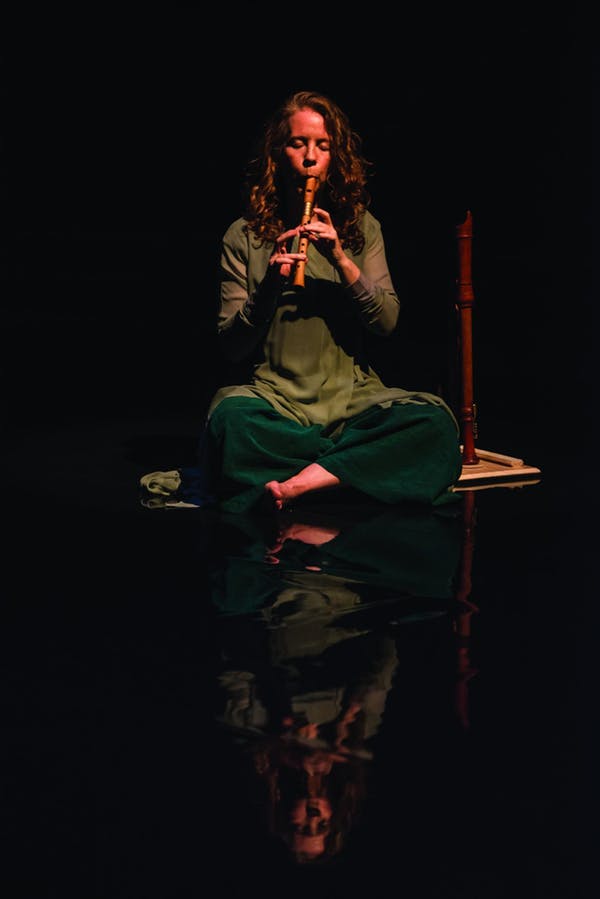
One Infinity’s stage resembles a mirror or a lake’s surface. Photo by Gregory Lorenzutti.
Performed to UK composer Max de Wardener’s electronic ambient music, the instinctual and unsophisticated body movements of the dancers highlight physical movement and the biological complexity of individual human bodies. This evokes the western system of knowledge, based on science, materialism and individualism. We are presented with dualism, the (Chinese) spiritual nature and the (western) material nature.
One of the best parts of One Infinity is that the musicians each feature separately in different parts of the performance, thus letting their music shine in its own way, without having their collaboration reduced to some hybridized, chop-suey-ish, musical bricolage.
In this way, One Infinity does not intend to represent pure harmony and unity between East and West. It constantly reminds us of tensions and differences among the various forms of exchanges we can identify in the performance: between western and Chinese music, classical music and contemporary dance, Australian and Chinese dancers, and professional performers and the audience.
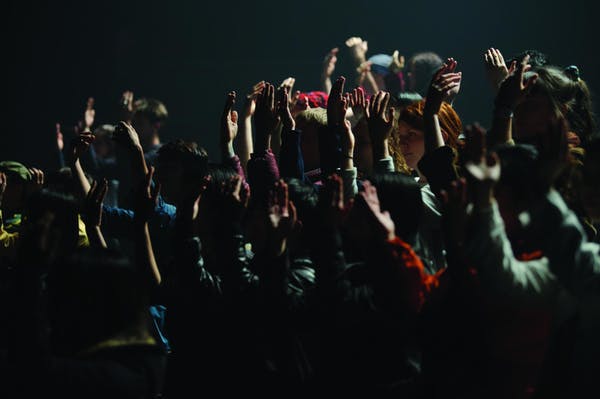
“One Infinity” also involves audience participation. Photo by Sarah Walker.
Audience engagement and participation also play a role throughout the show, as the audience is led to participate with simple (but occasionally quick and vigorous) hand gestures. While our moves were far from synchronized, the ripples and waves we created turned out to be a surprisingly satisfying sight. Together, we disappeared into a sea of patterns, and became part of something larger than ourselves.
One Infinity offers a subtle reminder that in cross-cultural exchange, Confucius’s famous saying “to harmonize but not to unify (he er bu tong)” still has its relevance
We aim not to achieve uniformity, but to keep the desire to connect, to understand, to resist dominance, to pay mutual respect, and to constantly seek more common grounds.
This article was originally posted at theconversation.com on February 6th, 2019, and has been reposted with permission. To read the original article, click here.
This post was written by the author in their personal capacity.The opinions expressed in this article are the author’s own and do not reflect the view of The Theatre Times, their staff or collaborators.
This post was written by Kiu-wai Chu.
The views expressed here belong to the author and do not necessarily reflect our views and opinions.

